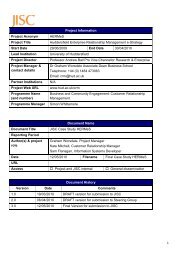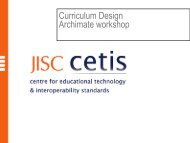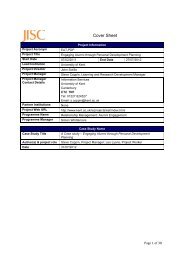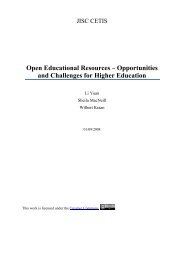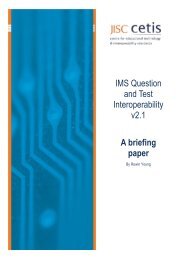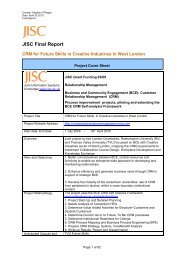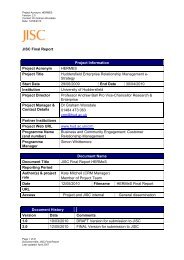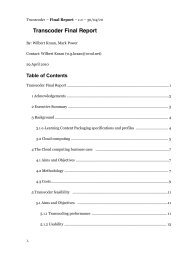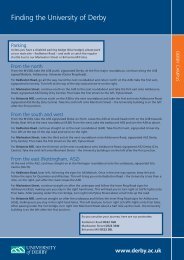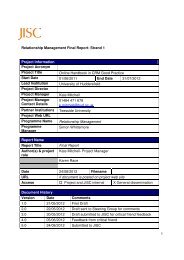COVA- COURSE VALIDATION ARRANGER - CETIS Wiki
COVA- COURSE VALIDATION ARRANGER - CETIS Wiki
COVA- COURSE VALIDATION ARRANGER - CETIS Wiki
You also want an ePaper? Increase the reach of your titles
YUMPU automatically turns print PDFs into web optimized ePapers that Google loves.
<strong>COVA</strong>- <strong>COURSE</strong> <strong>VALIDATION</strong><br />
<strong>ARRANGER</strong><br />
Evaluating BPM Toolsets For Higher<br />
Education<br />
Balbir Barn, Barn Samia Oussena<br />
THAMES VALLEY UNIVERSITY<br />
{balbir.barn, { , samia.oussena}@tvu.ac.uk }@<br />
<strong>CETIS</strong> Enterprise SIG Meeting April 4 th 2008
Agenda<br />
Introduction to the project<br />
Background, <strong>COVA</strong>RM Scenarios<br />
<strong>COVA</strong> Project Aims and Objectives<br />
Approach Taken<br />
A very brief introduction to BPMN 1.0<br />
Current Results<br />
Video Demonstration<br />
Final comments
Introduction to the project<br />
CCourse Validation ld Arranger A (<strong>COVA</strong>) (CO A) builds b ld on the h<br />
outcomes from the <strong>COVA</strong>RM project<br />
Th The <strong>COVA</strong>RM project j (http://covarm.tvu.ac.uk/covarm)<br />
(h // k/ )<br />
key relevant outcomes were:<br />
A (large) synthesised business process model describing<br />
course validation activities<br />
An approach pp to managing g g large g complex p processes p using g a<br />
decomposition approach based on events and sub-processes<br />
Two sub-processes or scenarios were implemented using<br />
WSDL Services implemented in JAVA, executed using BPEL and<br />
ORACLE BPEL Process Manager
Two sub-processes sub processes / Scenarios<br />
End to End process is large, complex and has<br />
multiple stop – start points (event entry points)<br />
Technical feasibility limited to developing sub- subsections<br />
of the process – scenarios<br />
1. Prepare programme proposal<br />
To get the initial approval to develop the new programme<br />
2. R Run Validation V lid i EEvent<br />
To arrange the setting up of an event
Scenario 1: Set up Validation Event<br />
Notification<br />
ValidationDocSpecificationSet<br />
«Report» Validation Event Minute<br />
Convene Panel<br />
Constraint::Panel i l Membership b hi<br />
Issue Documentation to<br />
Panel Members<br />
Get Feedback db k<br />
Event Logistics<br />
Run Validation Event<br />
Review i All ll Documentation i<br />
Produce Event Minute
BPEL Process Definition from Domain<br />
Sub-processes<br />
Narrative Description<br />
1-1<br />
Calendar_Port<br />
ValDoc_Port<br />
Timetabling_Port<br />
BPEL Process<br />
Definition<br />
ECows_Port<br />
Notification_Port<br />
Choreography<br />
constraints<br />
LearningProductSpecfica<br />
tion_Port<br />
ProcessParticipatio<br />
n_Port<br />
Sample operation details<br />
For one service
Emerging issues and evaluation<br />
BPEL Modelling Toolsets<br />
BPELWSDL Links: Problems with complex p data types yp<br />
in message flows<br />
Have to break down complex types into simple types on<br />
message flows<br />
Work arounds available<br />
WSDL t to Code Cd generation ti<br />
New methods added to wsdl require full re-generation<br />
of code leading g to cut and paste p of old business logic g<br />
BPEL Modelling Toolsets<br />
7
8<br />
Model Transformations<br />
Single<br />
transformation<br />
IBM Rational XDE<br />
Issues:<br />
Operation Specs<br />
IBM Rational Software<br />
Architect<br />
Model<br />
changes<br />
Multiple transforms<br />
XSD Schemas<br />
Multiple toolsets and notations<br />
Multiple toolsets and notations<br />
Multiple training requirments<br />
JDeveloper<br />
Scenarios<br />
BPEL specs<br />
BPEL Process<br />
Manager<br />
Manual WSDL<br />
production
COVa – Course Validation Arranger<br />
Key Drivers<br />
Technical demands of using bespoke process implementation<br />
technology (<strong>COVA</strong>RM example)<br />
Multiple toolsets and notations<br />
Wid Widespread d adoption d i of f the h OMG standard d d for f process<br />
modelling – BPMN 1.0<br />
Emerging implementations of BPM toolsets<br />
Open source and Commercial products<br />
Increasing importance of role of process modelling within<br />
Higher Education<br />
Elaboration of process p modelling g<br />
needs in the e-Framework
<strong>COVA</strong>: Aims and Objectives<br />
Ai Aims:<br />
To explore the potential of open source business process<br />
management g solutions as viable approach pp for the support pp of<br />
common administrative processes in HE<br />
Objectives<br />
A demonstration implementation of the two <strong>COVA</strong>RM<br />
scenarios using a BPM toolset such as Intalio Designer.<br />
An evaluation of a BPM toolset an all encompassing<br />
environment<br />
Workshop collatoral on Process modelling and BPMN 1.0<br />
C b h k(<br />
Contributions to the e-Framework (services, process<br />
modelling concepts)
Approach Taken
BPMN 1.0 on 4 slides<br />
What is BPMN?<br />
The BPM lifecycle y<br />
A sample business process in BPMN<br />
Th The BPMN 1.0 1 0 notation t ti<br />
Most toolsets have not implemented all aspects of the<br />
notation<br />
i
13<br />
What is BPMN?<br />
M N MN<br />
Business Process Modelling Notation –BPMN<br />
A flowchart based notation for defining business<br />
processes<br />
An agreement between many modelling tool<br />
vendors to use a single unified notation<br />
Benefits to end users in terms of training<br />
Enables generation of an executable business<br />
process from business level understanding
The BPM Life cycle<br />
Technical change is accepted:<br />
14<br />
Human change g<br />
-Assess human capability<br />
-Human implications of process<br />
change<br />
-Human change g management<br />
requirements<br />
g<br />
evaluation<br />
case data<br />
analysis y<br />
design<br />
enactment<br />
monitoring<br />
requirements<br />
Ideally performed in a single<br />
tool or a set of integrated<br />
toolsets<br />
process model<br />
implementation<br />
infrastructure<br />
case data Model based<br />
-The model is the process<br />
-Process is self-documenting<br />
-Design is self-executing
15<br />
A sample business process in BPMN<br />
Start Event<br />
Task<br />
Gateway<br />
Sequence q<br />
Flow<br />
Sub-Process<br />
End Event
Business Process Modelling Notation - BPMN<br />
Adapted from White, S. (2005), Object Management Group. http://www/omg.org
Current Results<br />
BPMN<br />
workshops and<br />
other collateral<br />
IImplementation l t ti<br />
of “Prepare<br />
P<br />
Programme<br />
Proposal”<br />
Methodology gy<br />
Guidance<br />
Process Patterns
BPMN Guidance and Methodology<br />
BPMN workshops<br />
Presentational Workshop material on BPMN and process modelling in<br />
general has been developed and is available on request.<br />
Whole Day workshop | 3 hour workshop | 1.5 hour workshop<br />
Handouts available at:<br />
http://samsa.tvu.ac.uk/cova/Business%20Process%20Modelling-<br />
Workshop.pdf<br />
Guidance Notes on Process Modelling for JISC Domain Maps<br />
Available as draft – currently waiting for JISC to do final editing<br />
Extended abstract-along with readings list available at:<br />
http://samsa.tvu.ac.uk/cova/ProcessModellingGuidanceNotesAbstrac<br />
tt.pdf pdf
UML<br />
Model<br />
Implementation of “Prepare<br />
Programme Proposal”<br />
Analysis<br />
Model<br />
Implementation<br />
Model<br />
Intalio Designer Toolset<br />
Translate <strong>COVA</strong>RM<br />
UML model into<br />
BPMN<br />
Implement BPMN<br />
model using<br />
<strong>COVA</strong>RM Services<br />
Execution of<br />
Scenario in Toolset<br />
TTranslation l into BPMN<br />
Methodology needs<br />
Appropriate selection of<br />
notations<br />
Intalio Implementation of<br />
BPMN<br />
Implementing the scenario<br />
CConsume <strong>COVA</strong>RM CO A M WSDL WS<br />
services<br />
Forms Design in Intalio<br />
Mapping of data from<br />
forms to services
Analysis Models in BPMN - methods<br />
MDA principles:<br />
Computation independent model (CIM)<br />
Platform Independent model (PIM)<br />
Platform Specific model (PSM)<br />
Producing a CIM in Intalio presents methodology<br />
issues:<br />
Full expressive power of BPMN not available<br />
Need to represent joint activities in a single org unit<br />
How do you represent a “Panel” or “Committee”?<br />
Support for exchange of information between Roles in<br />
Support for exchange of information between Roles in<br />
the same org. Unit
Examples of Methodology Issues<br />
CM CIM needs for f TIMER M events
Sequence and Message constraints<br />
BPMN rule: sequences in the same pool; message<br />
(information) flow across pools:<br />
But we need to share information between roles in<br />
the same pool p (University): ( y) E.g. g Computing p g Dept, p ,<br />
Registry.<br />
Use of naming conventions:<br />
University: Registry<br />
Ui i C i D<br />
University: Computing Dept Universi<br />
Coordinating Tasks<br />
Univerrsity:<br />
Comp Dept<br />
Registr<br />
ity:<br />
ry
Intalio Implementation - Services<br />
Existing <strong>COVA</strong>RM WSDL<br />
Services<br />
New XCRI Service<br />
- output XML
Intalio Implementation: - Forms
Consuming Services and mapping data<br />
between forms and services
Execution – video....<br />
Please check the <strong>COVA</strong> website for video<br />
availability<br />
http://samsa.tvu.ac.uk/cova/
Some Issues in using Intalio<br />
AAutomatic t ti creation ti of f variables i bl (from (f WSDL) t to b be used d in i the th process,<br />
makes any change to WSDL requires re-work of the mapping activity<br />
Intalio makes it difficult to use types from WSDL schema. It will generate 2<br />
imports one for the WSDL and another one when the type is assign to a<br />
variable. And this leads to conflicting schema. The workaround that I used<br />
is to create an equivalent schema and use it for the process variable.<br />
Intalio requires complete specification in gateways – expression for the IF<br />
and the ELSE must be completed even if not required.<br />
Data is often required to be saved in intermediate variables to be used for<br />
a condition or in a sub process (different Context)<br />
The Community Edition for Intalio is shipped with an embedded database<br />
which is not scalable for large processes. (Need to reconfigure the server<br />
for MySQL. y<br />
Intalio does allow you to import a WSDL (service) so you end up cut & past<br />
the WSDL. It does not handle the import of schema in a WSDL. Here as<br />
well you are required to cut&paste.<br />
Minor bugs – updates in data mapper not reflected in the data editor<br />
Usability: resizing sub-processes or lanes; Printing is in-adequate. Debugging<br />
is difficult.
Conclusion<br />
Even when h using BPM M toolsets l implementing l and d<br />
executing HE business processes appears to be TOO<br />
HARD!<br />
BPMN provides a realisable strategy for HE to deliver<br />
a computation independent model of systems<br />
Process modelling needs to be a first order concept in<br />
the e-Framework<br />
e Framework<br />
QUESTIONS?



